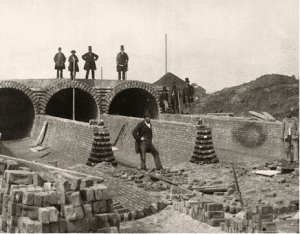Since the Victorian era there has been a recognition that increasing population density in cities requires investment in infrastructure. In London in the early 19th Century the sewers ran directly into the Thames and the water supply was badly contaminated. Cholera outbreaks were frequent. In 1849, Dr John Snow identified that contaminated water was transmitting the cholera bacteria and in 1856, Joseph Bazalgette, chief engineer for the Metropolitan Board of Works, was given the responsibility for creating the modern London underground sewerage system. There is no doubt that the population density of the city of London could not be supported without this critical infrastructure that is still in use.
Higher levels of population density, in both Greenfield and Urban Renewal developments, requires innovative infrastructure. To meet the demands
of modern high density living, developers are increasingly turning to the private sector to provide innovative infrastructure for Electricity, Hot and Cold water, Gas and Telecommunications and Community services in new developments.
To deliver cost effective outcomes above and beyond what can be achieved by simply augmenting existing infrastructure, new solutions must act synergistically to achieve higher levels of efficiency.
For example, at One Central Park in Sydney, a trigeneration system uses gas to generate electricity, hot water and cold water for cooling. System elements use networks for communication and control. The network connection of community infrastructure elements is the foundation of what we are now calling – a Smart City.

Image: Bazalgette viewing the Northern Outfall branch of the new London sewer system. BBC Image Source: http://theappendix.net
IS BROADBAND ENOUGH?
What is a ‘Smart City’ and how does it differ from the built-form we are accustomed to today?
A Smart City uses Information Communications Technology (ICT) network infrastructure to connect and manage the assets of a city or community precinct. As we move towards the age of the Internet of Things (IoT) we expect that community infrastructure will also be enabled for network connectivity and remote control. Even with the roll out of National Broadband Network infrastructure can we be sure that communities can access the full benefit of integrated connectivity? Not necessarily – Broadband alone is not enough.
Commercially available fixed line broadband is typically delivered by a Retail Service Provider (RSP). That is fine for a household or business, however what if a connection is required for a water pump, power meter, solar panel, wayfinder, electric car charger or any of the devices required to enable a smart city? All those devices have network capability, however if they are to work as a part of an integrated Smart City system, then they all need to be connected to a Local Area Network (LAN) with a very low cost per connected device. Telecommunications networks are typically a Wide Area Network (WAN) with a price per connection set at a retail price point. If every IoT device in smart city has to be connected at a retail price point the cost would be prohibitive.
The solution is to engage a private sector Telecommunications Carrier who can provide low cost access for a community to a LAN for device in a Smart City in addition to providing the WAN to provide residential and commercial broadband services.
Guest blog submitted by Opticomm